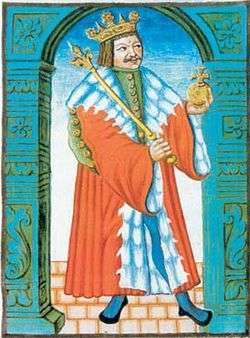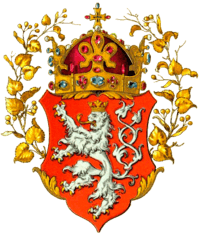George of Poděbrady
| George of Poděbrady | |
|---|---|
 Jiří of Poděbrady depicted in a codex from 1607 | |
| King of Bohemia | |
| Reign | 1458–1471 |
| Coronation | 2 March 1458, Prague[1] |
| Predecessor | Ladislaus I Posthumus |
| Successor | Vladislaus II |
| Born |
23 April 1420 probably at Poděbrady Castle |
| Died |
22 March 1471 (aged 50) Prague |
| Spouse |
Kunigunde of Sternberg Johana of Rožmitál |
| House | Poděbrady |
| Father | Victor of Munsterberg |
| Mother | Anna of Wartenberg |
| Religion | Utraquist Hussite |
| Wikimedia Commons has media related to George of Podebrady. |
George of Kunštát and Poděbrady (23 April 1420 – 22 March 1471), also known as Poděbrad or Podiebrad (Czech: Jiří z Poděbrad; German: Georg von Podiebrad), was King of Bohemia (1458–1471). He was a leader of the Hussites. He is known for his idea and attempt to establish common European institutions. It is seen as the first historical vision of European unity.
Early life
George was the son of Victor of Munsterberg, a Bohemian nobleman, one of the leaders of the Utraquists, the more moderate faction of the Hussites during the Hussite Wars. At the age of fourteen, George himself took part in the Battle of Lipany, which marked the downfall of the more radical Taborites.
Early in life, as one of the leaders of the Hussite party, he defeated the Austrian troops of the King Albert II, who had succeeded King Sigismund as King of Bohemia, Germany and Hungary. Jiří soon became a prominent member of the Hussite party, and after the death of Hynek Ptáček of Pirkstein, its leader.
King Albert was succeeded by his posthumously born son Ladislaus, during whose reign Bohemia was divided into two parties: the party faithful to Rome, led by Oldřich of Rosenberg (1403–1462), and the Hussite party, led by George.
After various attempts at reconciliation, George sought a military decision. He gradually raised an armed force in north-eastern Bohemia, where the Hussites were strong and where his ancestral castle Litice was situated. In 1448, he marched this army, about 9000 strong, from Kutná Hora to Prague, and obtained possession of the capital almost without resistance.
Civil war broke out, but George succeeded in defeating the nobles who remained faithful to Rome. In 1451 the emperor Frederick III, as guardian of the young king Ladislaus, entrusted Poděbrad with the administration of Bohemia. In the same year a diet assembled at Prague also conferred the regency on George.
Ruler of Bohemia
The struggle of the Hussites against the papal party continued uninterruptedly, and the position of George became a very difficult one when the young king Ladislaus, who was crowned in 1453, expressed his pro-Roman sympathies, though he had recognized the compacts and the ancient privileges of Bohemia. In 1457 King Ladislaus died suddenly and some voices accused George of having poisoned him. Research in 1985 gave acute leukemia as the cause of death.
On 2 March 1458 the estates of Bohemia unanimously chose George as king. Even the adherents of the papal party voted for him, some in honour of his moderate policies, some out of deference to popular feeling, which opposed the election of a foreign ruler.
George attempted to rule in a moderate manner based on the Compacta of Prague. He won the loyalty of some Catholics, but had to contend with the opposition of Pope Pius II, which proved one of the most serious obstacles to his rule. Pius declared the Compacta null and void in 1462 and wished George to consent to this. George rejected this demand but endeavoured to curry favour with the Roman See by punishing the more extreme Hussites.
The message of peace
George attempted to secure peace with Rome by a radical suggestion, which some consider to have been a proposal before its time of a European Union.[2][3] He proposed a treaty among all Christian powers, Hungary, Poland, Lands of Bohemian Crown, Bavaria, France, and Italy and its princes the founding members, but others, especially the Hispanic powers, joining later. The member states would pledge to settle all differences by exclusively peaceful means. There was to be a common parliament and other common institutions. George couched the proposal in Christian terms ("Europe" is not explicitly mentioned) as a way to stop the "abominable Turk" who had conquered Constantinople in 1453. He sent Leo of Rozmital on a tour of European courts with a draft treaty of The message of peace to promote this idea. George hoped that the treaty would come into effect in 1464. It is seen as one of historical visions of European unity foreshadowing the European Union.[4]
That did not happen. All George's endeavours to establish peace with Rome proved ineffectual, although Pius II's plan of a crusade against Bohemia remained unexecuted.
After Pius' death in 1464, George attempted to negotiate with the new pope, Paul II, but Paul proved to be an equally determined opponent.
George made enemies among the nobles of the papal party, who assembled at Zelená Hora (Grüneberg) on 28 November 1465 to voice their grievances and conclude an alliance against the king. This alliance was from the outset supported by Pope Paul II and on 23 December 1466 the Pope excommunicated George and pronounced his deposition as king of Bohemia, releasing all subjects of the Bohemian crown from their oaths of allegiance to George. Emperor Frederick III and the Hungarian king Matthias Corvinus, George's former ally, joined the insurgent Bohemian nobles, starting the Bohemian War. King Matthias conquered a large part of Moravia, and was crowned by the papal party in the Moravian ecclesiastical metropolis Olomouc as king of Bohemia on 3 May 1469.
George was successful against Matthias but, contrary to the wishes of his followers, came to an agreement with the Hungarian king in 1470.
He died on 22 March 1471 and his followers chose Vladislaus II, the son of the Polish king, as his successor to continue the fight against Matthias.
Marriages and children
In 1440 he married Kunigunde of Sternberg; they had the following children:
- Boček (15 July 1442 – 28 September 1496)
- Victor (29 May 1443 – 30 August 1500), Imperial prince, Duke of Munsterberg and Opava and Count of Kladsko
- Barbara (1446–1469), married firstly to Henry of Lipé and secondly to John of Ronov
- Henry the Elder (1448–1498), married Ursula of Brandenburg, daughter of Albert III, Margrave of Brandenburg
- Katharina (11 November 1449 – 8 March 1464), twin of Sidonie, married Matthias Corvinus of Hungary, however died young
- Sidonie (11 November 1449 – 1 February 1510), twin of Katharina, called Zdeňka, married Albert III, Duke of Saxony
After Kunigunde died in 1449 after childbirth, he remarried to Johana of Rožmitál in 1450, they had the following children:
- Henry the Younger (18 May 1452 - 1 July 1492) married Catherine, daughter of William III, Duke of Saxony
- Frederick (1453–1458), died young
- Agnes?, believed to have married in Wallachia
- Ludmila (16 October 1456 – 20 January 1503), married Frederick I of Liegnitz
Ancestors
| Ancestors of George of Poděbrady | |||||||||||||||||||||||||||||||||||||||||||||||||||||||||||||||||||||||||||||||||||||||||||||||||||||||||||||||||||||||||||||||||||||||||||||||||||||||||||||||||||||||||||||||||||||||||||||||||||||||||||||||||||||||||||||||||||||||||||||||||||||||||||||||||||||||||||||||||||||||||||||||||||||||||||||||||||||||||||||||||||||||||||||||||||||||||||||||||||||||||||||||||||||||||||||||||||||||||||||||||||||||||||||||||||||||||||||||||||||||||||||||||||||||||||||||||||||||||||||||||||||||||||||||||||||||||||||||||||||||||||||||||||||||||||||
|---|---|---|---|---|---|---|---|---|---|---|---|---|---|---|---|---|---|---|---|---|---|---|---|---|---|---|---|---|---|---|---|---|---|---|---|---|---|---|---|---|---|---|---|---|---|---|---|---|---|---|---|---|---|---|---|---|---|---|---|---|---|---|---|---|---|---|---|---|---|---|---|---|---|---|---|---|---|---|---|---|---|---|---|---|---|---|---|---|---|---|---|---|---|---|---|---|---|---|---|---|---|---|---|---|---|---|---|---|---|---|---|---|---|---|---|---|---|---|---|---|---|---|---|---|---|---|---|---|---|---|---|---|---|---|---|---|---|---|---|---|---|---|---|---|---|---|---|---|---|---|---|---|---|---|---|---|---|---|---|---|---|---|---|---|---|---|---|---|---|---|---|---|---|---|---|---|---|---|---|---|---|---|---|---|---|---|---|---|---|---|---|---|---|---|---|---|---|---|---|---|---|---|---|---|---|---|---|---|---|---|---|---|---|---|---|---|---|---|---|---|---|---|---|---|---|---|---|---|---|---|---|---|---|---|---|---|---|---|---|---|---|---|---|---|---|---|---|---|---|---|---|---|---|---|---|---|---|---|---|---|---|---|---|---|---|---|---|---|---|---|---|---|---|---|---|---|---|---|---|---|---|---|---|---|---|---|---|---|---|---|---|---|---|---|---|---|---|---|---|---|---|---|---|---|---|---|---|---|---|---|---|---|---|---|---|---|---|---|---|---|---|---|---|---|---|---|---|---|---|---|---|---|---|---|---|---|---|---|---|---|---|---|---|---|---|---|---|---|---|---|---|---|---|---|---|---|---|---|---|---|---|---|---|---|---|---|---|---|---|---|---|---|---|---|---|---|---|---|---|---|---|---|---|---|---|---|---|---|---|---|---|---|---|---|---|---|---|---|---|---|---|---|---|---|---|---|---|---|---|---|---|---|---|---|---|---|---|---|---|---|---|---|---|---|---|---|---|---|---|---|---|---|---|---|---|---|---|---|---|---|---|---|---|---|---|---|---|---|---|---|---|---|---|---|---|---|---|---|---|---|---|---|---|---|---|---|---|---|---|---|---|---|---|---|---|---|---|---|---|---|---|---|---|---|---|---|---|---|---|---|---|---|---|---|---|---|---|---|---|---|---|---|---|---|---|---|---|---|---|---|---|---|---|---|---|---|---|---|---|---|---|---|---|---|---|---|---|---|---|---|---|---|---|---|---|---|---|---|---|---|---|
| |||||||||||||||||||||||||||||||||||||||||||||||||||||||||||||||||||||||||||||||||||||||||||||||||||||||||||||||||||||||||||||||||||||||||||||||||||||||||||||||||||||||||||||||||||||||||||||||||||||||||||||||||||||||||||||||||||||||||||||||||||||||||||||||||||||||||||||||||||||||||||||||||||||||||||||||||||||||||||||||||||||||||||||||||||||||||||||||||||||||||||||||||||||||||||||||||||||||||||||||||||||||||||||||||||||||||||||||||||||||||||||||||||||||||||||||||||||||||||||||||||||||||||||||||||||||||||||||||||||||||||||||||||||||||||||
See also
References
- Claus Bernet (2003). "Podiebrad, Georg von". In Bautz, Traugott. Biographisch-Bibliographisches Kirchenlexikon (BBKL) (in German). 21. Nordhausen: Bautz. cols. 1183–1203. ISBN 3-88309-110-3.
- Colette Beaune: Chrétienté et Europe : le projet de Georges de Podiebrad au xve siècle, in: Chrétiens et sociétés, vol. 1, 1994, uploaded 8 July 2008 (in French).
- Frederick G. Heymann. George of Bohemia. King of Heretics. Princeton, N.J.: Princeton University Press, 1965.
- Otakar Odložilík. The Hussite King. Bohemia in European Affairs 1440–1471. New Brunswick, N.J.: Rutgers University Press, 1965.
- Josef Macek. Jiří z Poděbrad. Praha: Svobodné slovo, 1967.
- Anthony D. Smith. "National Identity and the Idea of European Unity" International Affairs, Vol. 68, No. 1 (Jan., 1992), pp. 55–76
Footnotes
- ↑ "The Royal Route". Královská cesta. Retrieved 11 July 2013.
- ↑ Colette Beaune: Chrétienté et Europe: le projet de Georges de Podiebrad au xve siècle, in: Chrétiens et sociétés, vol. 1 | 1994, uploaded 8 July 2008 (in French)
- ↑ Jacques Le Goff: The Birth of Europe, Malden, MA: Blackwell, 2005
- ↑ Anthony D. Smith. "National Identity and the Idea of European Unity" International Affairs, Vol. 68, No. 1 (Jan., 1992), pp. 55–76
George of Poděbrady Cadet branch of the Lords of Kunštát Born: 23 April 1420 Died: 22 March 1471 | ||
| Regnal titles | ||
|---|---|---|
| Preceded by Ladislaus the Posthumous |
King of Bohemia 1458–1471 |
Succeeded by Vladislaus II & Matthias I |
